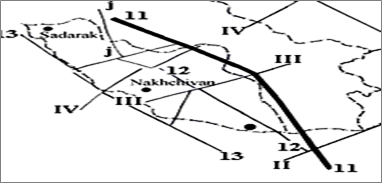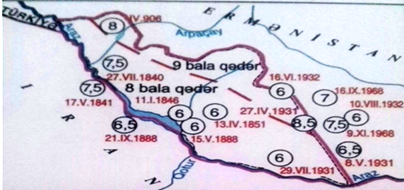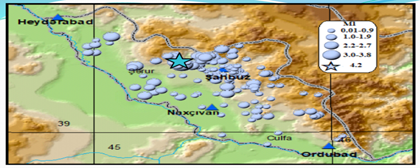eISSN: 2574-8092


Opinion Volume 9 Issue 1
Head of the Department of Seismological Service of the Institute of Natural Resources, Azerbaijan
Correspondence: Valibayov Ilkin Mehman, Head of the Department of Seismological Service of the Institute of Natural Resources, Nakhchivan Branch of ANAS
Received: March 06, 2023 | Published: April 4, 2023
Citation: Mehman VI. Regularity of the depth distribution of earthquakes on the sharur-ordubad fault. Int Rob Auto J. 2023;9(1):52-53 DOI: 10.15406/iratj.2023.09.00263
The territory of the Nakhchivan Autonomous Republic is located in the south-east of the Anatolian block, in the west at the junction of the Iravan and Saderak sloping plains, between the Arab and Eurasian plates, surrounded by the Darelayaz and Zangezur ranges extending to the north-west and north-east, and bordered by the Araz River in the north-west of Iran. Located in the central part of the continental collision zone. As a result of this convergence, the movement of the Anatolian block to the west and the movement of the Iranian block to the east is observed. Strong earthquakes that occur as a result of the resulting deformation occur along seismogenic zones bordered by active faults. The seismicity of the area and the tremors occurring in the Sharur-Ordubad fault is the result of this convergence. Earthquakes in this fault are mainly distributed at depths of 3-25 km.
Nakhchivan Autonomous Republic is located in the southern and southeastern part of the Caucasus. Its territory lies between 38°51' - 39°47' north latitude and 44°46 '- 46°10' east longitude.1 Almost 66% of the area is above 1000 m above sea level. In the north, Darelaez, and in the east, the Zangezur range of mountains stretches.2 As a result of the influence of modern tectonic movements, the area was involved in a general uplift and was subjected to intensive fragmentation. The faults of the foundation of the territory of Azerbaijan, especially the territory of the Nakhchivan Autonomous Republic up to the Alps, are depicted on the map below. Faults are trans-Caucasian and transversal and demarcate the area with different blocks. It is assumed that the trans-Caucasian faults are Paleozoic in age, and the transversal faults are Mesozoic in age Figure 1.

Figure 1 Faults: IV - Arpa - Samur, III - Nehram - Lekatag, 13- South Araz, 4-Sharur-Goyche, 12-Sharur-Ordubad, 11 - Zangezur (T.N. Gangarli).
Regional faults are included in the center of the Araz tectonic megazone, which are bordered by Girratag in the northeast, Ashagi Araz (Palmira - Absheron) in the southeast, North Tabriz in the southwest, and Ağrıdag in the west.3 In various periods of history, strong earthquakes have occurred in connection with these faults and resulted in many casualties. In the years 735, 906, 1308, 1406, 1931 in the territory of Armenia, which is the north-eastern border, in the years 1042, 1641, 1721, 1780 and 1786, in and around the city of Tabriz, East Azerbaijan province, in the south and south-west border of Iran, in the west Strong earthquakes occurred in Eastern Anatolia of the Republic of Turkey in 1840, 1976, and 2011. The listed earthquake epicenters are located 100-150 km from the territory of the autonomous republic. The intensity of a part of these earthquakes reached 7-8 points according to the MSK - 64 scale in the territory of the autonomous republic Figure 2.

Figure 2 Map of the intensity of strong earthquakes in the territory of the autonomous republic in different years.
In the Nakhchivan Autonomous Republic, the processing of earthquakes is carried out based on the data of four telemetric stations. The fact that these seismic stations have a large dynamic range (135 dB) increases the accuracy of the lossless recording of earthquakes occurring in the area and nearby border regions and the determination of their coordinates Figure 3.
Using these opportunities, it can be considered very necessary in terms of the seismic regime of earthquakes occurring in the Armenia-Nakhchivan part, in the border areas of Iran and Turkey near us, the prediction of strong earthquakes, the study of the stress deformation process occurring in the earth's crust, comparative analysis and study of seismicity. These stations were installed along the Sharur-Ordubad fault in the Transcaucasia direction. The stations are equipped with equipment manufactured in the USA and Switzerland. Focal parameters of earthquakes are processed by the program "Antelope 5.6" in the Department of Seismological Services. When studying the seismicity of the Autonomous Republic and looking at the historical period and based on the conducted paleoseismological studies, it can be said that there are no focal zones that generate strong earthquakes in the territory of the republic. Looking at the seismicity of the Autonomous Republic's own territory, an earthquake with a magnitude of ml>4 was recorded in 2021. On January 23, this earthquake had a magnitude of ml=4.2 in the Sharur-Ordubad fault, 15 km west of Shahbuz station, and it was felt up to 5 points in the areas near the epicenter, and up to 4-3 points in the surrounding areas, and it covered the entire territory of the autonomous republic.
The Sharur-Ordubad fault is one of the 4 segments of the Sardarabat-Nakhchivan fault. The most active segment with earthquakes is the Sardarabat segment. The length of the Sardarapat - Nakhchivan fault is 300 km, the length of the total segments is approximately 340-350 km. Starting from the city of Kagızman (Turkey), the segments extend to the territory of Armenia, passing through the south of the city of Yerevan, to the north of the Dvin and Gamarli territories. After that, it extends from the north-west side of the Nakhchivan mulda to the east side, passing through the Daridag fault in the south-east direction, in the form of a continuous system in the direction of the city of Marand (Iran) towards southern Azerbaijan Figure 4.

Figure 4 Epicenter map of earthquakes that occurred in the territory of the autonomous republic in 2021.
The regularity of the distribution of earthquakes on the general profile of the epicenter map of the earthquakes that occurred in the territory of the autonomous republic in 2021 was studied. The occurrence of earthquakes in the territory of the autonomous republic in 2021 was associated with the activation of the Sharur-Ordubad fault Figure 5.
Earthquakes with magnitude ml ≥3.0 occurred within the sedimentary layer at a depth of 3-10 km. In the Hyderabad-Nakhchivan part, the distribution of earthquakes on the depth of Arazboi plain areas was 15-25 km, and activity was observed in the 15-5 km layer at the border of the plain mountainous areas.
None.
Author declares that there is no conflict of interest.

©2023 Mehman. This is an open access article distributed under the terms of the, which permits unrestricted use, distribution, and build upon your work non-commercially.